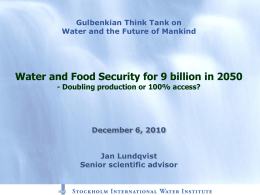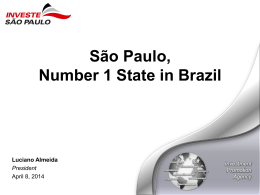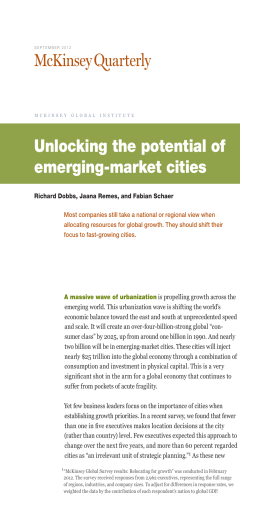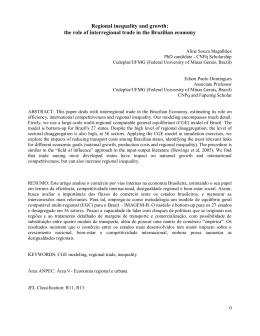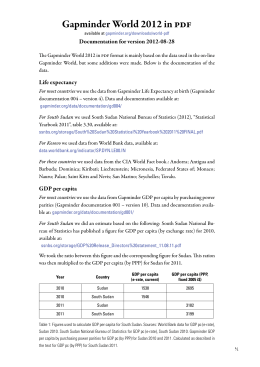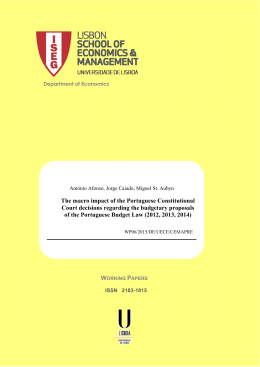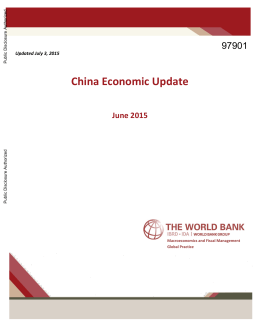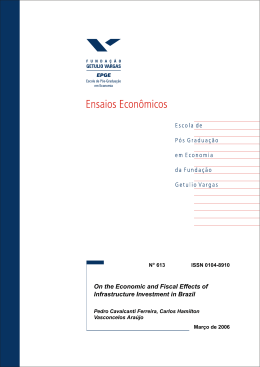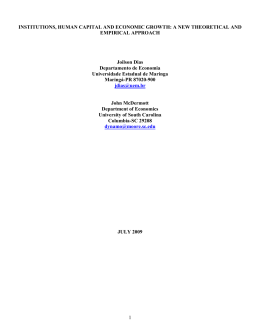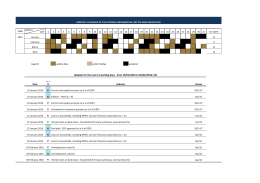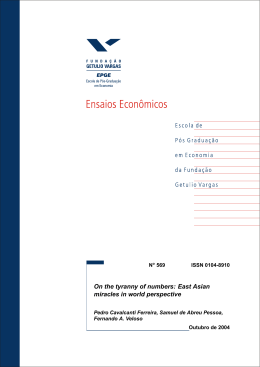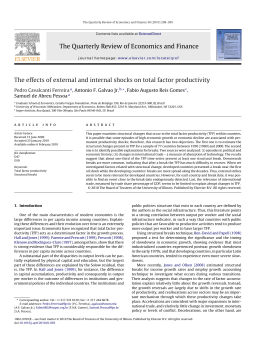BRAZIL’S GROWTH POTENCIAL: SOME NUMERICAL EXERCISES EDMAR BACHA Seminário Para Onde Vai a América Latina? IBRE-FGV 08/10/2012 EXERCISES ARE ON GDP GROWTH SERIES FROM 1948 WITH EMPHASIS ON POST-2004 PERIOD 15.0% 12.5% Yearly GDP growth rates (Y') Ten-year moving average 10.0% 7.5% 5.0% 2.5% -2.5% -5.0% 2010 2008 2006 2004 2002 2000 1998 1996 1994 1992 1990 1988 1986 1984 1982 1980 1978 1976 1974 1972 1970 1968 1966 1964 1962 1960 1958 1956 1954 1952 1950 1948 0.0% A SOLOW DECOMPOSITION: y’ = (Y/L)’ = TFP’ + α(uK/L)’ Decomposition of GDP per Worker Growth (y)', 1948-2011 (%) 1948-62 1963-67 1968-73 1974-80 1981-92 1993-99 2000-11 y’ 4.4 2.4 5.7 3.6 -0.8 0.7 1.2 TFP’ 1.67 0.50 3.30 0.90 -1.00 0.25 1.00 % of y’ 0.38 0.23 0.58 0.26 1.37 0.35 0.81 0.46(uk)’ 2.73 1.80 2.40 2.70 0.30 0.45 0.20 % of y’ 0.62 0.77 0.42 0.74 -0.37 0.65 0.19 2005-11 1948-11 2.0 2.3 1.40 0.85 0.70 0.37 0.60 1.43 0.30 0.63 Memo: L’ 3.1 0.6 5.8 3.9 0.4 2.3 2.4 2.0 1.8 TWO STYLIZED FACTS • GDP growth, TFP and capital deepening all collapsed after 1980 • TFP recovered more recently, but capital accumulation remains under par DETERMINANTS OF CAPITAL ACCUMULATION K’ = s(1/p)uv Decomposition of Capital Growth (K ') (1948-2011) Periods K ' (% p.y) s (% GDP) u (%) v 1/p (=1.0 in 2000) 1948-62 8.9 14.8 97.1 0.68 1.42 1963-67 6.6 15.8 92.6 0.61 1.25 1968-73 9.6 19.5 96.5 0.59 1.25 1974-80 9.8 22.6 96.2 0.55 1.20 1981-92 3.3 19.2 89.8 0.46 1.01 1993-99 2.3 17.0 93.1 0.44 1.02 2000-11 2.7 17.3 94.6 0.46 0.97 2005-11 3.5 18.3 95.5 0.47 0.98 Total 6.0 17.7 94.4 0.55 1.16 STYLIZED FACTS ABOUT K’ • Capital accumulation collapsed after 1980 • “Nominal” savings as such does not seem to be the main problem. Critical issue is “real” savings: loss of purchasing power of savings over investment: s/p (68-73) = 19.5x1.25=24.4 s/p (05-11) = 18.3x0.98=17.9 • Also, output/capital-in-use ratio (v) is much lower than before • Modest recovery of K’ more recently RECENT K’ RECOVERY SEEMS TO BE BASED ON EXTERNAL BONANZA DOMESTIC SPENDING RATIOS TO GDP, 2005 PRICES YEAR GFCF/Y FAMC/Y GOVC/Y A/Y 2005 0,16 0,60 0,20 0,96 2006 0,17 0,61 0,20 0,98 2007 0,18 0,61 0,20 0,99 2008 0,19 0,61 0,19 1,02 2009 0,18 0,64 0,20 1,02 2010 0,20 0,64 0,19 1,04 2011 0,21 0,64 0,19 1,05 BONANZA FORMULA IN NEXT PAGE EXPLAINED • Domestic spending equals domestic income plus foreign transfers: PAA = PYY + F • Foreign transfers equals the excess of imports over exports: F = PMM - PXX • External bonanza is measured as the excess of domestic spending over income in constant 2005 prices: A/Y - 1= (P – 1) + Z where: P = PY/PA (‘terms of trade’ effect) Z = F/PA Y (foreign transfer effect) IS THIS SUSTAINABLE?... A/Y -1 = (P-1) + Z Decomposition of External Bonanza, 2005-10 (in 2005 prices) Year Terms of Foreign Excess of Trade Transfer Spending Effect Effect over GDP (P - 1) Z (A/Y - 1) 2005 0,0% -3,6% -3,6% 2006 0,7% -2,9% -2,2% 2007 0,9% -1,5% -0,6% 2008 1,7% -0,2% 1,5% 2009 1,8% 0,2% 2,0% 2010 3,4% 1,1% 4,4% 2011 4,4% 0,8% 5,2% ...doubtful, unless Brazil opens up (range of imports G&S/GDP, 2007-11, %) • • • • • • Argentina Brazil Chile Colombia Mexico Peru 16-22 11-13 32-40 17-20 29-32 20-27 • • • • China India Russia South Africa 22-30 24-30 20-22 28-34 • Average (except BR) 23-28 CONCLUSIONS • Brazil’s GDP growth and capital accumulation collapsed after 1980 • Recently, there has been some recovery of GDP growth and capital accumulation (plus TFP’) • Extraordinary external bonanza may explain why recovery of K’ occurred (TFP’ too?) • Once the bonanza is over, ceteris paribus, Brazil’s growth should retreat to under 4% p.y. • Main problem seems to be that Brazil is closed to imports. Which suggests that increased openness is the way to higher growth. REFERENCES • Edmar Bacha and Regis Bonelli “Accounting for the rise and fall of post-WW-II Brazil's growth”, forthcoming. • Edmar Bacha, “Bonança externa e desindustrialização: uma análise do período 2005-2011”, forthcoming in E. Bacha and M. de Bolle (eds.), O Futuro da indústria no Brasil: desindustrialização em debate. Civilização Brasileira, 2012.
Download

